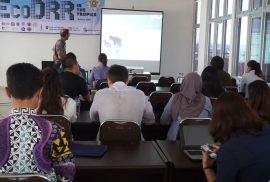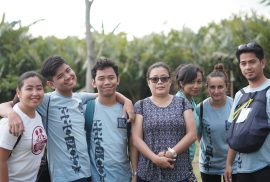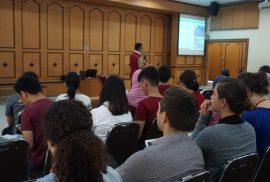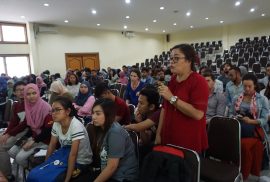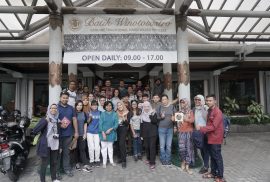23th August 2017 – Another day has passed and I gained new knowledge as this summer course almost comes to an end. I started my morning like the usual time, had usual breakfast menu and walked the same route to UGM. The 10th day of summer course started with the first session of the lecture on “Understanding Climate Change Problem” by Dr. Suko Prayitno Adi. He explained about some of the causes and effects of climate change which may contributes to natural disaster which it would increase the weather and climate hazards. Next contributes to increase in the vulnerability of communities to natural hazards. Some of the examples are ecosystem degradation, food availability and changes in livelihood. In his lecture, he mentioned about the adaptation through the risk reduction management and explained about the role of Hyogo framework in which disaster risk reduction management should be local and international priority along with strong institutional implementation. Furthermore, early warning systems are much needed to identify, asses and monitor on disaster occurrence possibility. Next, it is truly important to have the knowledge, innovation education to build a culture of safety and resilience at all level thus reduce the underlying factors. Lastly, it is a must to strengthen the disaster management for effective response.
Summercourse 2017 Daily Activity
One of the activities during the 2017 Ecosystem-based Disaster Risk Reduction was visiting the E-Pujiono Learning House. Located in Dukuh Karanglo, Desa Donoharjo, Kecamatan Ngaglik, Kabupaten Sleman, Provinsi Daerah Istimewa Yogyakarta, Indonesia, this Learning House, established on Mei 6, 2017, aimed at becoming means of learning for advancing public understanding of disaster resilience and climate change adaptation. The E-Pujiono Learning House is part of the Pujiono Study Center (Pujiono Center, abbreviated as PUCEN) was established on June 12, 2012, to serve as a think-tank with headquarters in Yogyakarta, Indonesia. PUCEN focuses on issues and debates on disaster resilience, humanitarian response, emergency response management, and social work profession dimensions on disaster risk management and climate change adaptation.
More UGM experts on their respective fields of specializations took centerstage today. Their presentation taken all together creates a wider picture of how sciences must collaborate, exchange notes, share and listen to each other’s findings and in general just have an inter-discipline conversation so efforts to implement ecosystems-based disaster risk reduction initiatives. This would result to higher community resiliency and better environment management or restoration.
The presentation on Climate Change allowed everyone to have a common understating about the topic with the various definition, projections, some international frameworks prediction models. My personal reflection is that all sectors of the “earth’s citizenry” has to do their part. The international community, as one, already have spoken through the Hyogo and Sendai conference. Now it’s time for governments, scientists, corporations and other stakeholders has to take initiatives in their own countries and contribute and, for example, lessen carbon emissions and invest in renewable energy. Emphasis must be for Corporations.
Again, with a lovely day to start with a typical Indonesian style of breakfast. It was the last field visit and of course the mesmerizing one. We started our journey from the Cakra Kusuma hotel towards the northern part of Yogyakarta special region to witness the glory of Mt. Merapi, one of the most active volcanoes of the world. It is located in the central part of Java Island. It has been observed from the bus that how the life of the people of Yogyakarta entirely dependent on the landscape of volcanic events throughout the ages. Mt. Merapi is also called the ‘Mountain of Fire’ in Javanese. Furthermore, Merapi volcano plays a significant role to boost the tourism and an income generating source for the local inhabitants.
Alright, so today the day began with a lot of mix feelings. The days were passing so fast that today we actually had the last field trip. They say, the best is kept for the last and it was. The day was short and brief yet memorable one definitely.
Today holds many different packages of surprises and the first of them was unfolded at the hotel. Yes, among of all the fieldtrip days, today on the last day the committee decided to treat us with a different bus which was actually turned out to be a good one too. After having our so called morning roll call, the bus set it course towards to Merapi Museum.
After several days of activities including fieldtrip, workshop and the Amazing Race, on the eigth day it was time again to build up more theoretical knowledge on the topic of Eco-DRR. Accordingly the participants came to the University, although not to the normal classroom, but to the larger Merapi Auditorium, due to a larger groups of students also participating for the first two guest lectures. The first lecture was held by Dr. Seca Gandaseca from the
University Putra Malaysia. He definitely succeeded in the task to delivering an informative, as well as entertaining session as it could be observed in the listener crowd. His primary field of expertise is the forestry sector which is why the lecture could be summarized as a combination of just that sector with the key terms vulnerability, disaster and risk. He also made connections to climate change and the influence of humans. While introducing with an explanation of the ecosystem “forest”, he then continued to describe the interpretation of disaster, i.e. that disasters are actually a natural phenomena which cannot be stopped by mankind, but risk can be reduced through people’s behavior. In the next part of the session Dr. Seca Gandaseca explained the term of adaptation and gave some examples of means of prevention and mitigation.
It felt like a dream, now that I think about it. Summer course has entered its 8th day, and now it’s our final week in here. 6 more days to go before the course ends and I felt like time passed by so quick. I haven’t had enough of enjoyment and fun in here, and I felt like I’ve yet accomplished anything. I wish the course extends for another week, but then I still have my final year projects that I need to settle. Such tough thing that boggled up my mind as I woke up from my bed early in the morning and it kind of ruined my mood.
Today is another exciting day because we are making our own Batik and do the amazing race. Batik is a technique of wax-resist dyeing applied to a cloth, it is made either by drawing or a stamp tool called canting. Although, other countries have the Batiks as part of their culture, the Indonesian Batik however is best known for its unique and traditional designs.
Going back, at 8:30, we were gathered at the hotel by group and were given instructions; each group will book a grab car going to the Batik Winotosastro. Our group was the last one to arrive though; other participants are already waiting inside. We had a short orientation on how to do Batik, we are fascinated by how meticulous and artistic the women there in making the batiks. Each of us were give a piece of cloth then we have to make one by ourselves, there are lots of canting to choose from and I literally had a hard time finding the design because there’s just too is many beautiful designs and the fact that I’m not that artistic, I can’t decide which one. It was really funny because I was looking at everyone’s work and I was like, it’s all beautiful. Thanks for Adit and Maulan and the people there for helping me out on the design. And so went to the area where they dye the batik, I choose dark blue for my batik and we waited for like 10-15 minutes I guess, and tadaah! I have my batik neatly packed and sealed. And of course before we leave for another activity, we had a group picture with the owner of the shop.
The day started with a Bruno Mars song “that’s what I like” and a hot coffee from the hotel around 6:00 am. A French toast and again coffee in the hotel Restaurant at 8:30 am while waiting for the other participants to arrive. Instructions about the day’s itinerary and changes in team composition was also discussed. I was assigned to Team 6 from the previous team 4, having Romulo of Davao DRRM Office, Philippines, Cresency Umely Anak Udin of Universiti Putra Malaysia and Fazila Beknakzarova of Tsukuba University, Japan from Tajikistan. The team already discussed tasking the night before the activity. Tasking was made by Romulo of the Philippines, I will do the questions for the Key Informat Interview, Cresency of Malaysia is our tour guide and interpreter and Fazila of Tajikistan will be the narrator for the video.


